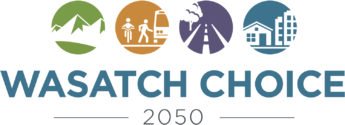
In close collaboration with our local communities and transportation partners, the Wasatch Front Regional Council (WFRC) staff undertook a robust process to develop the Wasatch Choice 2050 (WC2050) Vision and 2019-2050 Regional Transportation Plan (RTP).
WFRC measured the performance of the RTP and other efforts in relation to how well they met established goals. Three scenarios were developed to show the trade-offs associated with different transportation and land use investments. Select elements from each or some of the scenarios were then combined into a preferred scenario.
During February and March of 2017, WFRC staff along with the Utah Department of Transportation (UDOT), Utah Transit Authority (UTA), and key stakeholders met again with local communities at the sub-region level to refine the three scenarios into a shared single preferred alternative. This preferred alternative formed the foundation of both the WC2050 Vision and the 2019-2050 RTP. The workshops focused on gathering input about each scenario’s future land use patterns along with specific roadway, transit, and active transportation projects. Each of the scenarios identified potential growth centers, supporting transportation facilities, network connectivity, and critical open space to be preserved. In addition to designing three transportation and land use scenarios, WFRC staff formulated specific performance measures to quantify outputs to measure success for most of the adopted regional goals, and analyzed modeling results that assisted in evaluating and comparing each scenario.
Following the small area (or sub-region) meetings with local communities, WFRC staff performed significant partner and stakeholder outreach to gather input on these scenarios from over 50 transportation advocacy organizations, community advisory committees, special interest groups, and a number of individual cities who requested additional information or opportunity to comment. Additionally, WFRC offered an informative 45-minute webinar to inform attendees about the three different scenarios, as well as an opportunity to provide feedback.
Local communities provided feedback and public comment through the scenario development process. This collected feedback was used not only to develop the preferred scenario, but also to inform how the scenarios were evaluated. All public comments were provided responses by WFRC staff and compiled in the 2019-2050 Public Comment Log.
It is important to note that some criteria methodologies, models, and project lists were further refined, when needed, and therefore may not be directly comparable to the performance measures shown in other steps of the RTP process.
For additional information regarding the RTP, please contact Jory Johner.













